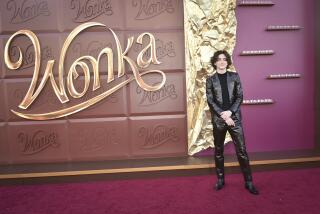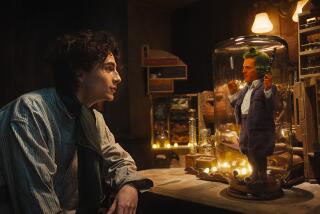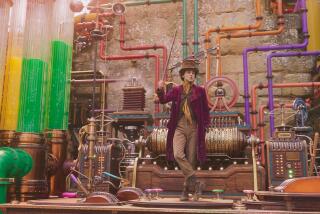That ‘70s Film About Willy Wonka
- Share via
You know you have a cult icon on your hands when your movie is being considered for a remake by director Tim Burton. But . . . “Willy Wonka and the Chocolate Factory?” The 1971 musical based on Roald Dahl’s classic children’s book “Charlie and the Chocolate Factory” didn’t burn down the box office in its day, but time is a powerful critic: This year Entertainment Weekly ranked “Willy Wonka” No. 25 on its list of the 50 top cult films of all time. The film got a 30-year anniversary DVD edition in 2001 and hundreds lined up in May for the big-screen showings that kicked off the exhibit of “Willy Wonka” memorabilia now on view at the David L. Wolper Center at USC.
Wolper produced “Willy Wonka,” along with a string of biggies that included epic TV miniseries such as “Roots” and “The Thorn Birds.” Cynical cinephiles might question the scholarly merits of a film exhibit at a hall of knowledge named after the film’s producer. But Wolper laughs at those who question the relevance of an exhibit devoted to “Willy Wonka.” “It started off as a simple film and became a cult film,” he says. “We wouldn’t [be having] an exhibit for ‘Heaven’s Gate.’ ” The movie, directed by Mel Stuart, was financed by Quaker Oats to promote a Wonka chocolate bar product. The candy never quite took off, Wolper says, but the film is going strong.
For the record:
12:00 a.m. Aug. 8, 2003 For The Record
Los Angeles Times Friday August 08, 2003 Home Edition Main News Part A Page 2 National Desk 1 inches; 63 words Type of Material: Correction
Willy Wonka -- The Aug. 3 article in the Los Angeles Times Magazine about a “Willy Wonka” exhibit at USC incorrectly stated that Wonka decided to give away his candy factory to five children. More accurately, he gives the five children a tour of the factory after they find golden tickets that have been hidden in chocolate bars as part of a contest.
For The Record
Los Angeles Times Sunday August 10, 2003 Home Edition Main News Part A Page 2 National Desk 1 inches; 63 words Type of Material: Correction
Willy Wonka -- The Aug. 3 article in the Los Angeles Times Magazine about a “Willy Wonka” exhibit at USC incorrectly stated that Wonka decided to give away his candy factory to five children. More accurately, he gives the five children a tour of the factory after they find golden tickets that have been hidden in chocolate bars as part of a contest.
For The Record
Los Angeles Times Sunday August 24, 2003 Home Edition Los Angeles Times Magazine Part I Page 4 Lat Magazine Desk 1 inches; 61 words Type of Material: Correction
The article about a “Willy Wonka” exhibit at USC (“That ‘70s Film About Willy Wonka,” Metropolis, Aug. 3) incorrectly stated that Wonka decided to give away his candy factory to five children. More accurately, he gives the five children a tour of the factory after they find golden tickets that have been hidden in chocolate bars as part of a contest.
In an era that revels in ‘70s nostalgia, the “Willy Wonka” phenomenon makes sense. Steve Hanson, head of the USC Cinema-Television Library, sees “Wonka” as emblematic of a certain zeitgeist. “There were not a lot of films that captured the fantasy of that time.” Actor Gene Wilder reached heights of tragic angst as Wonka, the reclusive genius who decides to give away his mysterious candy factory (complete with chocolate waterfalls and edible flowers) to five children who find golden tickets inserted in chocolate bars. Mayhem ensues when the children visit the factory and learn hard lessons about gluttony, greed, materialism and addiction to television. Songs from the Oompa Loompas, the diminutive workers who run Wonka’s factory, punctuate the action.
It’s the surrealism and a dark subtext that account for the movie’s staying power, its supporters say. “The movie has two lives when you see it,” says Wolper. “As a kid it’s one movie, and when you’re an adult it’s another movie.” There’s psychedelia such as the scene when a parent eats from a giant red-and-white polka dot mushroom. “A lot of people were probably high when they originally watched it,” Hansen says. “It’s sort of ‘The Wizard of Oz’ on drugs.” Then there’s the creeping unease lurking below the hallucinogenic whimsy. “People both love and fear the Oompa Loompas,” Hanson says. “It’s definitely not a children’s film. There are some scary scenes.”
The Willy Wonka exhibit is at the David L. Wolper Center at Doheny Memorial Library at USC through Sept. 18; (213) 821-3096.
*
(BEGIN TEXT OF INFOBOX)
One Film’s Legacy
Along with production material, the exhibit features such cultural artifacts as:
The home page from the “Sacred and Holy Church of Willy Wonka” Web site
A photograph of a man’s back adorned with a giant tattoo of Gene Wilder as Willy Wonka
A Marilyn Manson CD whose artwork depicts the singer as Willy Wonka
The Rush album “2112,” which cultists insist “syncs” to the film (a la “The Wizard of Oz” and Pink Floyd’s “Dark Side of the Moon”)
A cover from Metal Magazine showing a battle between a cartoon Ozzy Osbourne and Gene Wilder as Willy Wonka.
More to Read
The biggest entertainment stories
Get our big stories about Hollywood, film, television, music, arts, culture and more right in your inbox as soon as they publish.
You may occasionally receive promotional content from the Los Angeles Times.










